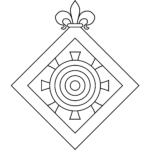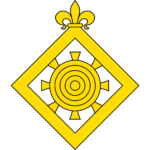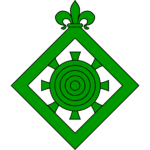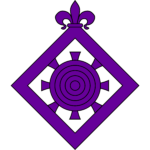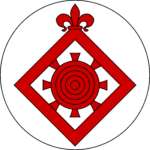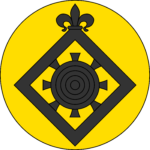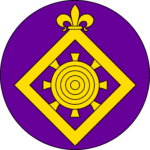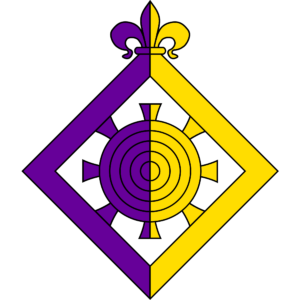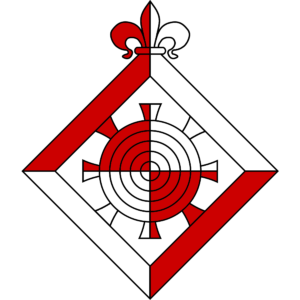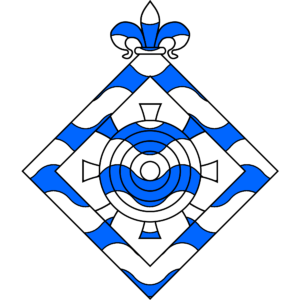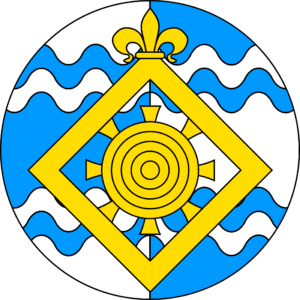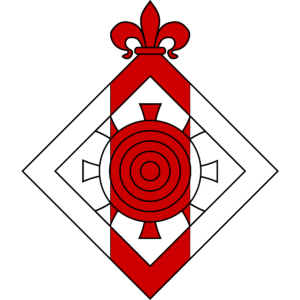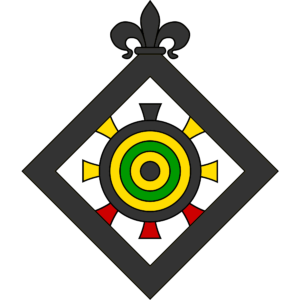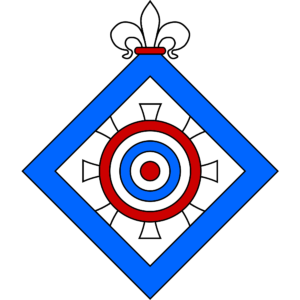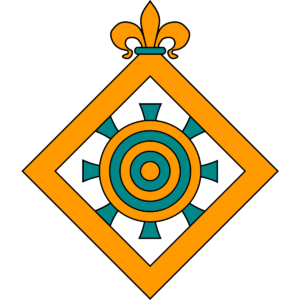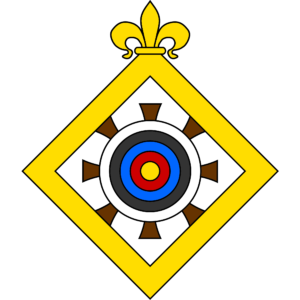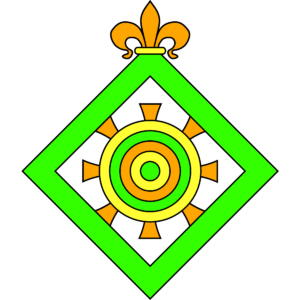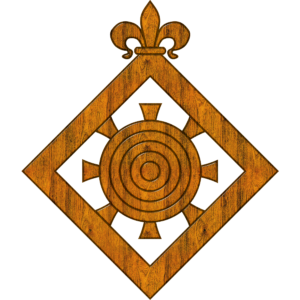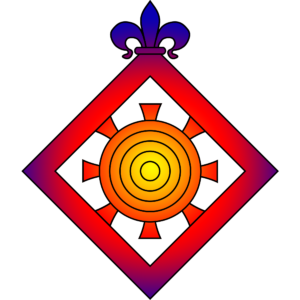As the badge for the Order of Esperance is being considered by both the College of Arms and the Board of Directors1, many have requested guidance on its depiction, and what kinds of artistic license people may take with it. This article breaks down the component parts of the badge, examines historical variations, and instructs the reader on what is and isn’t accepted practice.
The Badge for the Order of Esperance
The Order of Esperance badge is (Tinctureless) A set of nesting scale weights within and conjoined to a mascle fleury at the upper point. The art below is the official depiction (called an “emblazon”) of the badge as it’s currently being processed:
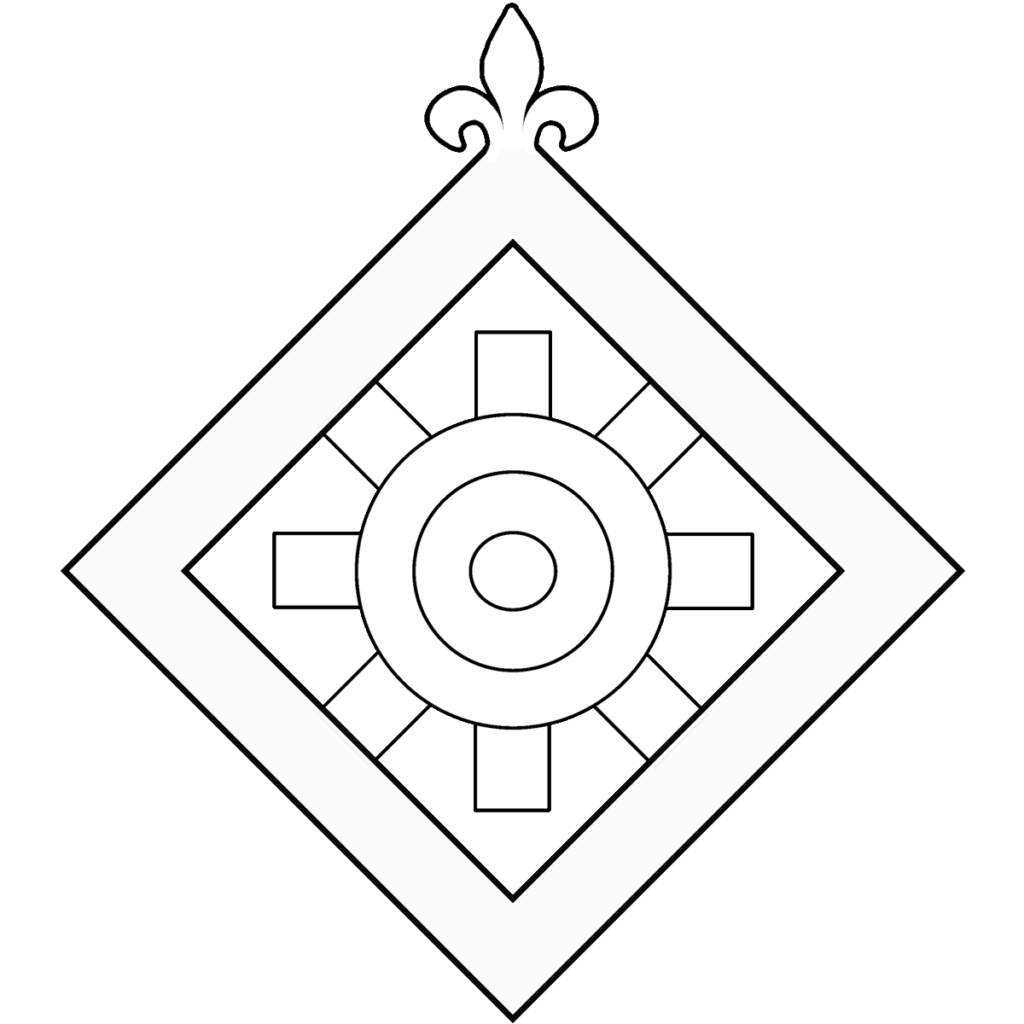
In order to be a valid depiction of the badge, each component part of the badge mentioned in the description (called the “blazon”) must be present: nesting scale weights, mascle, and fleury point. However, each of these components can be depicted with some variation, according to the whim’s of the artist, as long as they remain recognizable. This is what heralds refer to as “artistic license.”
The Parts of the Badge
Let’s break down this blazon into its component parts:
(Tinctureless)
This means that the badge can be any color (called “tincture”) or combination of tinctures.
A Set of Nested Scale Weights
A marco, or “set of nested scale weights” is depicted as a solid circle marked with concentric circles, representing the weights themselves, with a number of arms protruding out from behind the disc, representing the cradle which holds the weights.

Within and Conjoined to
This means that the set of nested scale weights must appear entirely within the mascle (see below), with parts connecting to the inside of the mascle in a way that makes the design a single unit.
A Mascle
A mascle is a rhomboid shape with a voided center.

Fleury at the Upper Point
A fleur-de-lys is a stylized iris or lily blossom that features three pointed petals, the ones on either side curved down. When a charge is described as “fleury,” it means that its points, ends, or edges are ornamented with the upper half of a fleur-de-lys.


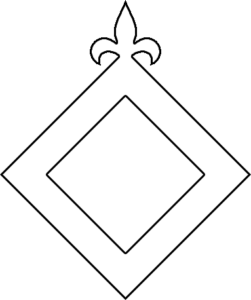
So, now that we’ve covered the basic components of the badge, we can look the variety of ways we can depict them. And to do so, we will look at period examples of marcos, mascles, and fleurs-de-lys.
Variations on a Theme
Below, please find several documented variables of each charge, along with advice on how to apply them to the overall design.
Fluctuating Weights
The marco, or set of nested scale weights, has a decent amount of variety in its depiction. Here are three known examples of the charge:

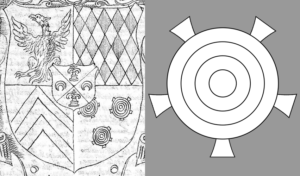

The charge has three variables: the rings on the disc, the number of arms, and the style of the arms.
The central disc has documented forms of between 3 and 6 concentric rings, including the disc itself. The total number of rings will depend in part on the size of the badge, but I would recommend no more than 6 for even the largest depictions.

As seen above, we have examples of marcos with 4, 5, and 8 arms. One might depict the badge with 6 or 7, but I would not recommend below 4 or above 8.

The arms of the marco have three known styles: straight, flared, or ployé (that is, flared with a curve). Again, we see the variables in the examples above.

Another consideration for depicting a marco is the angles of the arms. While our examples all have at least one vertical arm, one might imagine a four-armed marco with diagonal arms, or a six-armed marco with horizontal arms.
Diverse Diamonds
Another component of the badge with multiple variables is the mascle. Below are a couple of examples.

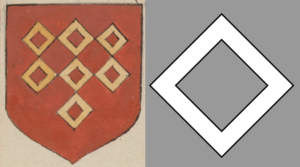
The charge has two variables: the relative height and width of the mascle, and the thickness of its perimeter.
Mascles are typically taller than they are wide, between 120-125% taller. However, we also have examples of mascles with right angles, a square frame turned 45 degrees. The internal rhombus tends to be between 50% and 80% of the dimensions of the total charge, with the perimeter tending to be thinner when around another charge.

When deciding whether to depict the badge with a square or narrow mascle, one aesthetic consideration should be the number of arms of the marco. While a 4- or 8-armed marco lends itself well to a square mascle, a 6-armed marco might look better with a mascle 1.73 times taller than it is wide.
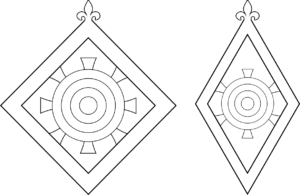
However, the artist must bear in mind that the narrower the mascle and the thicker its perimeter, the smaller the marco becomes. And as the marco is the primary charge of the design, it should be substantial enough to recognize and not be overwhelmed by the size of the mascle.
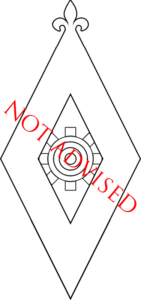
Likewise, the artist should take care not to make the mascle so narrow that its presence practically disappears into the background.

A Garden of Fleurs
Fleury tips are based on depictions of fleurs-de-lys. There are several stylizations of fleurs-de-lys, a small sampling of which appears below.
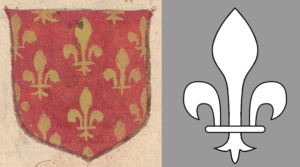

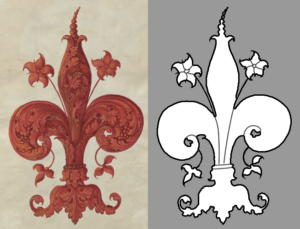
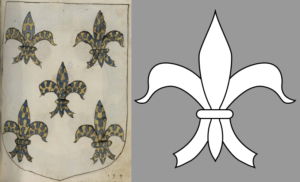
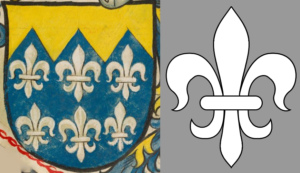
The central petal almost always has a point extending up, with curved sides. Sometimes the central petal has two convex sides, like a peapod, while other times the central petal has four concave sides, like a spearhead. The side petals curve outward with points, but the amount they pull away from the central petal or how much they curl under themselves has great variety based on region and individual artist. Many of the petals have space between each other, but they will just as often overlap. One notably baroque fleur-de-lys, the giglio bottonato of the arms of Florence (seen above), always has stamens displayed between the petals; we also see stamens in Spanish rolls unconnected with Florence, though they’re less pronounced.
While fleury ends aren’t as common as fleurs-de-lys themselves, we have examples of crosses fleury, escarbuncles and scepters (typically decorated with fleury ends), and other shapes and field divisions fleury at the points, edges, or ends.
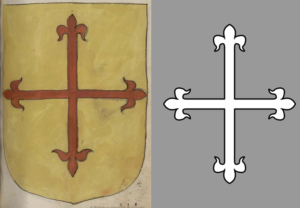
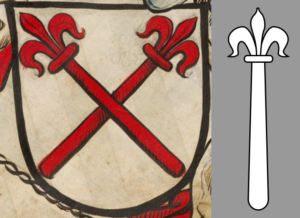
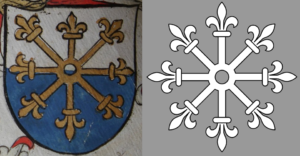
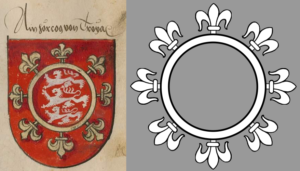
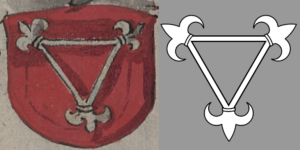
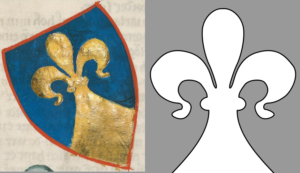
The closest period example to our design is a charge called a masculyn, which is a mascle fleury on all points.
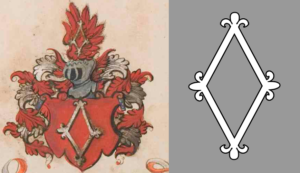
With period examples presented, we can identify several different opportunities for artistic license for the fleury end of the mascle.
The fleur may have a collar that binds the three petals, or the perimeter of the mascle may transition seamlessly into the fleur.
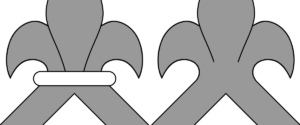
The petals may overlap or have gaps between them.
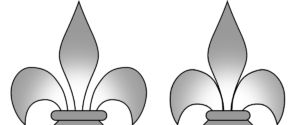
The side petals may curl under themselves, or their tips may twist into an s-shape.

The center petal may have a peapod shape, a round shape, or a spear shape.
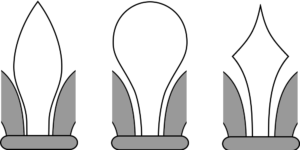
The relative size of the center and side petals might create a tall, wide, or roughly equal shape.
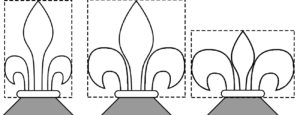 Regardless of the decisions made above, it’s important to find a good balance for the size of the fleur relative to the size and thickness of the mascle, and the overall size of the badge itself. The fleur, being a peripheral part of the design, be large enough to see, but not so large that it overwhelms the rest of the badge.
Regardless of the decisions made above, it’s important to find a good balance for the size of the fleur relative to the size and thickness of the mascle, and the overall size of the badge itself. The fleur, being a peripheral part of the design, be large enough to see, but not so large that it overwhelms the rest of the badge.
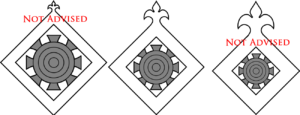
Summarizing the Options
Before we get to options for tinctures, a note: In the descriptions above, I’ve identified eleven variables for depicting the proposed badge for the Order of Esperance.
- The number of rings on the disc (4 options, 3-6)
- The number of arms on the marco (5 options, 4-8)
- The style of the arms on the marco (3 options: square, flared, ployé)
- The thickness of the mascle’s perimeter (3 options: thin, medium, thick)
- The width of the mascle (2 options: square, narrow)
- Whether the fleur has a collar separating the petals from the mascle (2 options: yes, no)
- Whether the fleur has space between its petals (2 options: yes, no)
- Whether the tips of the side petals curl in or out (2 options: in, out)
- The style of the center petal (3 options: convex point, round-top, concave spear)
- The relative dimensions of the fleur (3 options: tall, square, wide)
- The size of fleur relative to the rest of the mascle (3 options: small, medium, large)
If I’ve done the math right, that means that there are 77,760 permutations of this badge before we ever talk about tinctures. That is too many permutations for me to even begin to try to reproduce, so feel free to borrow the artwork above to create your own.
For this next section, I will use a variant that I personally find pleasing: Nested scale weights with five rings and eight ployé arms, within a square mascle of medium thickness topped with a modified form of the fleur from the Manesse Codex.
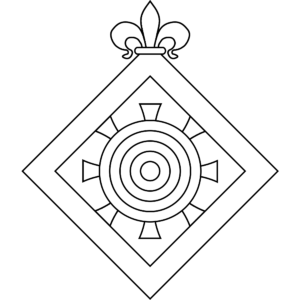
A Spectrum of Colors
As I note in my previous article, the badge for the Order of Esperance is tinctureless. This means that the badge can be any of the seven heraldic tinctures.
The badge may also be displayed on any heraldic tincture.
The badge may be divided in any of the heraldic field divisions, a small example of which appear below.
Individual elements of the badge may also be independently colored, and the interior of the mascle can be filled in by its background. Below are a few examples of the badge colored in motifs reminiscent of various kingdom arms and/or populace badges.
Coloration of a tinctureless badge may also extend beyond heraldic tinctures, allowing for members of the Order to personalize their displays even more.
As a final example, the medallion below was made by artisan Warin of Essex of Pierced Star Jewelry out of An Tir (no known online presence), and may be the first physical representation of the new order badge2:
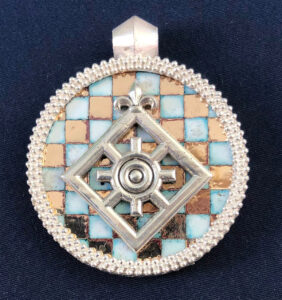
Conclusion
In this article, we discussed how to render the badge for the Order of Esperance. We reviewed various period styles of marco, mascle, and fleur-de-lys, considered the myriad style variations available to the artist, and explored just a handful of the infinite possibilities for coloring the badge. I hope that, armed with this information, you will be inspired to find a unique, balanced, and aesthetically pleasing version for a member of the Order3.
Footnotes:
- an opening phrase I will surely need to revise once the process is complete, and one that should reinforce to the reader that this design is far from final as of the date of this publication, September 6, 2024
- Note: This medallion was for display purposes when photographed and was not for sale. The College of Arms does not advise people to create displays of devices or badges before they are formally approved.
- Assuming the Board approves this badge which, as noted at the top of the article, has not yet happened.
